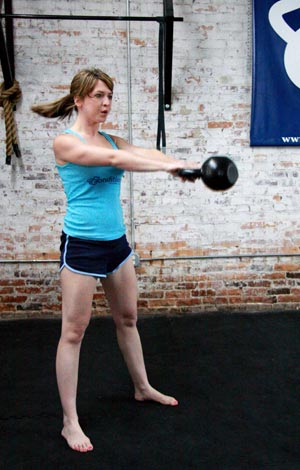How Hard is Hardstyle in Relation to the Kettlebell Swing?
Delaine Ross, RKC II
January 12, 2010 02:42 PM
When I attended the RKC II certification, I had a discussion with some of the participants. We noticed that a good many attendees were extremely tense throughout their entire body in their swings. We also recognized how great we felt after Senior RKC Jeff O'Connor's movement based section that included a piece on "taking the brakes off", which we did while swinging. So the question seemed to be "How 'hard' is 'Hardstyle" in relation to the kettlebell swing?"
There were people with solid, tense arms, hands crushing the handle, scrunched up faces, and necks jutting out. These people looked as if
they were in massive amounts of pain?and if they weren't at the moment they would be later if they continued to swing that way. Swinging "hardstyle" doesn't mean tense up every muscle in your entire body as hard as you can. There should be a balance of tension and relaxation. ?If you find yourself swinging with every muscle in your arms, neck, shoulder, and face tightened, you may have an overactive startle reflex. Do you find yourself making awful faces when drills get tough in your training? Or outside of the iron game, do you get overly tense in your neck and shoulders when stuck in traffic or working on an important assignment for the day job? If so, be conscious of that and purposefully relax your face, neck and shoulders. Whether it's sitting still on the highway or military pressing your one rep max, relax your face?I promise you'll still get the weight up and you'll feel better driving in your car.

Use the plank to swing analogy.?Get into a plank. Your glutes are tight. Your abs are tight. ?You are flexing your quads and hamstrings. But what about your face and neck? Your face should be relaxed and your neck should be loose enough to be able to shake your head. Apply that to your swing. At the top of your swing you're driving force into the ground with quads and hamstrings tight, glutes tight to lock your hips, abs tight to not leak power and to protect your back. But then what? Your shoulders are connected in to the sockets acting as the pivot point. Connected, but not squeezing so tight to be as tense as possible to the point of inhibiting the movement. Your arms are like ropes and your hands like hooks?not crush gripping the handle. Now check your neck and face. Your spine should be neutral, not allowing your neck to jut out like a chicken or pull back to give you a triple chin and your face should be relaxed, not squished up in what looks like agonizing pain.
Losing that balance of tension and relaxation is the first step on the pathway to inefficiency. Once that balance is gone you'll begin to lose your synchronized breathing, then your posture goes. What are you left with then? Really bad form? And since you get good at what you practice doing, you are getting good at doing really bad swings. Catch the problem on the first step and correct it. By being conscious of tensing when and where necessary and relaxing at the right place and time, your swings will be still tough and effective and you should feel "ready to battle a kingdom" (not ready to fall over dead) at the end of your training session.
Delaine Ross, RKC II, Z-Health Level I is based in Atlanta, GA. Her e-mail is delainerkc@gmail.com
Back